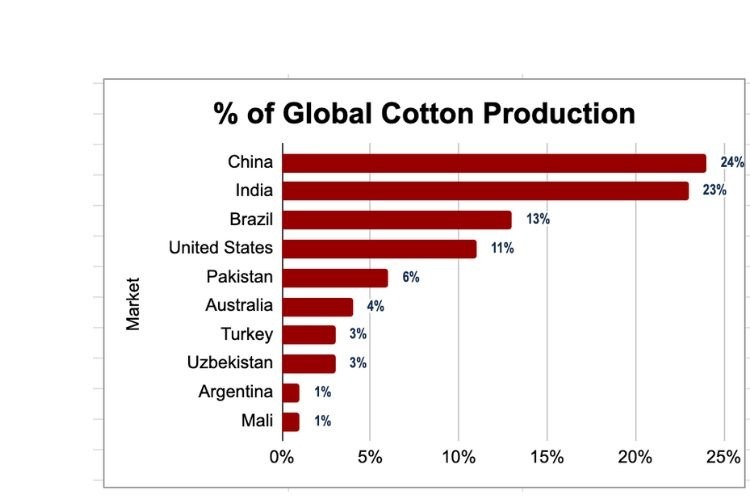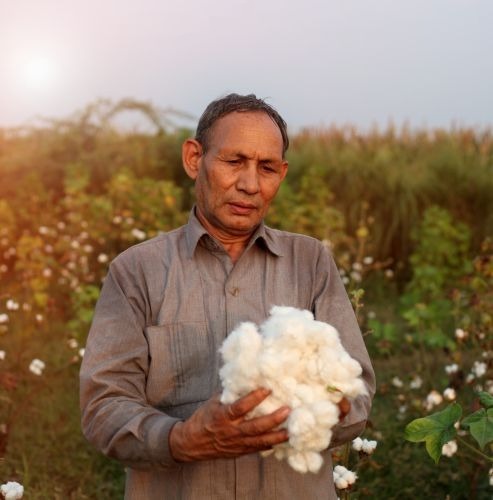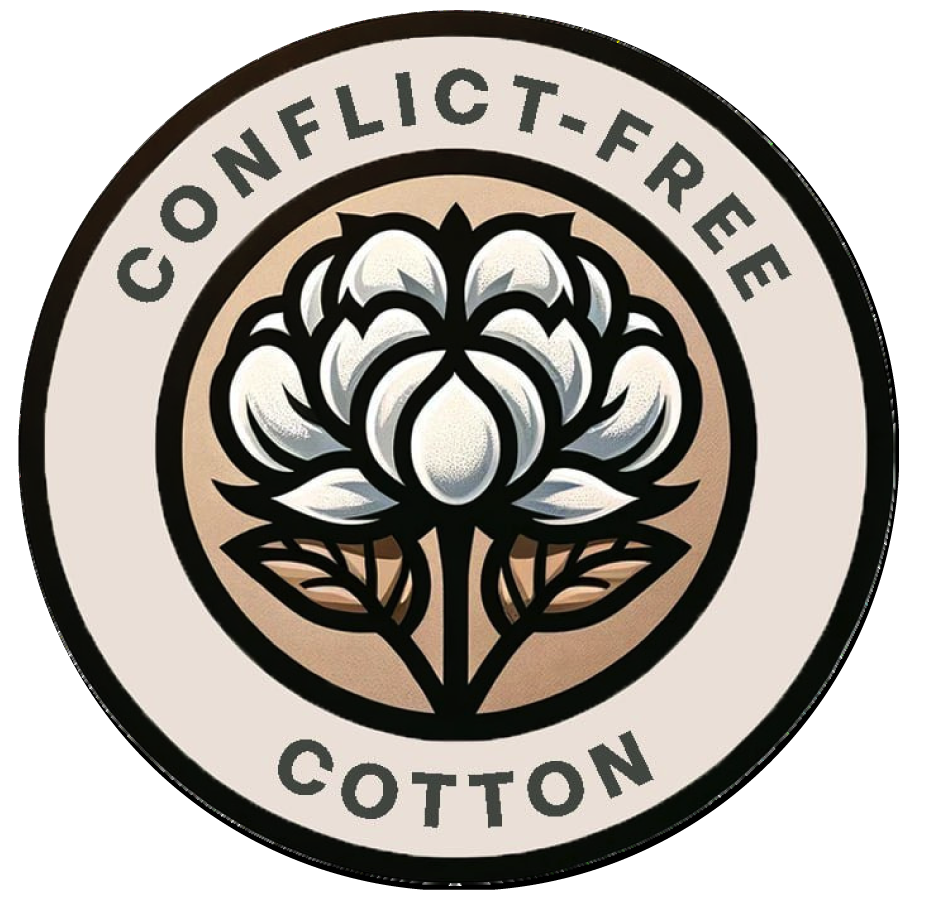Cotton Industry
The Cotton Industry: Where Cotton Grows
Cotton, a ubiquitous and versatile crop, forms the backbone of the global textile industry. Its cultivation spans numerous countries across the world, playing a crucial role not just in economic terms but also in the everyday lives of billions. From the clothes we wear to the fabrics that adorn our homes and even in the form of cottonseed oil in our kitchens, cotton's influence is pervasive. Yet, its cultivation is heavily skewed towards the developing world, where the majority of cotton farmers reside.
The Leading Cotton Producers

China and India are the giants of cotton production, collectively responsible for nearly half of the world’s output. Their dominance in the cotton market is a reflection of extensive agricultural infrastructure and favorable climatic conditions conducive to cotton cultivation.
- China produces about 27.5 million bales of cotton annually, making up 24% of global production. The country's vast cotton fields are primarily located in the Xinjiang region, where cotton is integral to the local economy.
- India accounts for 23% of the global production with 25.5 million bales. Cotton farming in India is widespread, involving millions of small to medium-sized farms across the country, particularly in states like Gujarat, Maharashtra, and Telangana.
Other significant contributors to the global cotton industry include:
- Brazil: With 14.56 million bales, Brazil contributes 13% to global cotton production, with the crop predominantly grown in the states of Mato Grosso and Bahia.
- United States: The U.S. produces 12.1 million bales, about 11% of the world's total. Major cotton-producing states include Texas, Georgia, and Mississippi, where advanced mechanization supports efficient large-scale production.
- Pakistan: Producing 6.7 million bales, Pakistan accounts for 6% of global production, with Punjab and Sindh being the primary cotton-growing regions.
- Australia: Known for its high-quality cotton, Australia produces 4.8 million bales, contributing 4% to the global market.
- Turkey, Uzbekistan, Argentina, and Mali also play significant roles in the cotton industry, each with unique challenges and contributions to the global supply chain.
The Significance of Cotton in Developing Countries

Approximately 99% of the world’s cotton farmers are based in developing countries, where agriculture not only forms a critical part of the economy but also serves as a lifeline for millions of households. The predominance of cotton cultivation in these regions highlights the importance of sustainable and ethical production practices, especially considering the challenges related to labor and environmental management.
Challenges and Opportunities
While cotton is a source of livelihood for millions, the industry is not without its challenges. Issues such as water consumption, pesticide use, and labor rights violations, particularly in countries with less stringent regulations, pose significant hurdles. However, these challenges also present opportunities for improvement, including the adoption of more sustainable agricultural practices, better labor standards, and the integration of modern technology to improve yield and reduce environmental impact. In summary, cotton's journey from the field to fabric is a complex interplay of geography, economics, and global trade. Understanding where cotton grows and the dynamics at play in each major producing country provides insight
Global Harvesting Practices and Ethical Concerns in Cotton Production
Cotton, one of the world's most vital natural resources, is pivotal to the global textile industry. However, its cultivation and harvesting come with substantial ethical concerns, particularly in labor practices across various regions.
Mechanized Harvesting
In developed nations like the United States and Australia, cotton harvesting is predominantly mechanized. This method involves using large machines such as cotton pickers and strippers that efficiently harvest vast fields in a short period. Mechanization minimizes the labor required and significantly reduces the potential for labor abuses.
Manual Harvesting
Contrastingly, in many developing countries, including India, Uzbekistan, and parts of Africa, cotton is still predominantly harvested by hand. Manual harvesting is labor-intensive and often involves the entire family, including children. The reliance on human labor is largely due to the lack of infrastructure, the small scale of farms, and the cost-prohibitive nature of mechanized tools in these regions.
Human Rights Challenges in Cotton Production

According to the U.S. Department of State 2020 Trafficking in Persons Report, cotton is listed as being produced with forced labor or forced child labor in Cameroon, China, India, Mali, Pakistan, Tajikistan, and Turkmenistan.
The ethical issues surrounding cotton production have not only humanitarian implications but also affect global trade. Many Western brands and retailers have begun to scrutinize their supply chains more closely, pressured by consumers and human rights organizations to source ethically produced cotton.
Child Labor and Forced Labor in Cotton Production
Child and forced labor in cotton production remain rampant in several countries. Notable among these are Turkmenistan, and India, where the economic reliance on cotton is profound. Despite international scrutiny and local reforms, these practices are deeply ingrained in the rural economies of these nations.
- Turkmenistan: This region has been under international watch due to its government-mandated labor systems. Historically, during the harvest season, students, teachers, and government employees have been forced to pick cotton under threats of punishment or job loss.
- India: In regions like Gujarat and Maharashtra, child labor in cotton fields is prevalent. Families often depend on their children to meet the high labor demands of manual harvesting, leading to severe disruptions in their education and exposure to hazardous conditions.
According to the U.S. Department of Labor List of Goods Produced by Child Labor or Forced Labor, cotton is produced with forced and child labor in Benin, Burkina Faso, China, India (cottonseed), Kazakhstan, Tajikistan, and Turkmenistan. Child labor is noted in Argentina, Azerbaijan, Brazil, Egypt, India (cotton), Kyrgyz Republic, Mali, Turkey, and Zambia. Forced labor is noted in Pakistan.
Government-Sanctioned Labor
In some regions, the government directly involves itself in cotton production, which often leads to abuse of power and forced labor. One prominent example is found in China:
- China: The Xinjiang Uyghur Autonomous Region, a major cotton-producing area, has seen widespread reports of forced labor involving Uyghur and other Turkic and Muslim minorities. These allegations include the coercive mobilization of labor under the guise of poverty alleviation and vocational training programs.
Conclusion
The journey of cotton from fields to factories is fraught with ethical challenges. As one of the largest employment sectors in the world, particularly in developing countries, the industry's impact on human rights cannot be understated. Going forward, a concerted effort from governments, corporations, and consumers will be necessary to address these issues. This includes supporting initiatives aimed at improving labor conditions, investing in mechanization in developing regions, and maintaining rigorous scrutiny of supply chains to eliminate forced and child labor in cotton production.
Ethical Cotton Sourcing: The Role of Leading Global Brands
The textile industry, a crucial component of the global economy, significantly impacts environmental sustainability and labor rights through its extensive use of cotton. As consumer awareness grows, major global brands that utilize substantial quantities of cotton face increased responsibility to ensure their supply chains are not only efficient but also ethical. Explore the practices of industry leaders in global cotton production and discover the critical role these companies play in promoting ethical sourcing standards. This section highlights how major brands are driving positive changes across the cotton industry, ensuring their supply chains support sustainable and humane practices.
The Leading Users of Cotton in Manufacturing
Several multinational corporations are known for their substantial use of cotton in manufacturing a wide array of products, from clothing and accessories to home textiles. These companies, due to their size and influence, have a pivotal role in shaping industry standards. By prioritizing ethical sourcing, they can significantly impact global cotton production practices.
These include:
- H&M (Hennes & Mauritz AB): Known for its fast-fashion products, H&M is one of the largest users of cotton worldwide. The company has committed to using 100% recycled or sustainably sourced cotton by 2030.
- IKEA Supply AG: As the world's largest furniture retailer, IKEA consumes vast amounts of cotton for home furnishing products. IKEA aims to ensure that all of the cotton it uses comes from more sustainable sources.
- Gap Inc.: This American retail giant uses cotton extensively in its apparel products across various brands including Gap, Old Navy, and Banana Republic. Gap Inc. participates in the Better Cotton Initiative to improve cotton farming globally.
- Adidas AG and Nike, Inc.: These sportswear behemoths use cotton in their clothing lines and have initiatives in place to increase their use of sustainable cotton. Adidas aims to achieve 100% sustainable cotton sourcing by 2025, while Nike is a member of the Better Cotton Initiative.
- Levi Strauss & Co.: Famous for its denim jeans, Levi's has implemented stringent guidelines for suppliers to improve environmental and social outcomes in its supply chain.
- PVH Corp.: Owning major brands like Tommy Hilfiger and Calvin Klein, PVH Corp has committed to sourcing 100% sustainable cotton by 2025.
Ethical Challenges in Cotton Production
Cotton production is fraught with ethical challenges, particularly in countries where labor laws are inadequately enforced. Key issues include:
- Forced Labor and Child Labor: Notoriously prevalent in regions like Turkmenistan, and parts of India. The global outcry over these practices has pushed companies to reconsider their supply chains.
- Government-Sanctioned Labor: In countries like China (Xinjiang region) government mandates have historically enforced cotton picking, leading to severe human rights violations.
Corporate Responsibility and Supply Chain Transparency
To combat these challenges, companies must adopt and enforce rigorous supply chain transparency. This involves:
- Tracking and Verification: Implementing systems to trace cotton from its origin to final products. This ensures the cotton is sourced from farms that adhere to ethical labor practices.
- Supplier Standards: Working closely with suppliers to uphold labor rights and environmental standards. This may involve regular audits and support for transitioning to sustainable practices.
- Alternative Sourcing: Seeking cotton from countries with stricter labor and environmental protections if current suppliers fail to meet ethical standards.
Impact of Ethical Sourcing Initiatives
The push towards ethical cotton sourcing has significant implications:
- Improving Lives: Ensuring fair wages and safe working conditions can dramatically improve the quality of life for millions of workers in the cotton industry.
- Consumer Trust: Brands that prioritize ethical practices tend to gain and retain consumer trust more effectively, aligning with the values of a socially conscious customer base.
- Environmental Sustainability: Sustainable cotton farming practices help preserve ecosystems, reduce water and chemical use, and decrease the overall environmental footprint of cotton production.
The responsibility of global brands in ensuring ethical cotton sourcing cannot be overstated. As leaders in the market, these companies have the power to effect substantial change, driving the industry towards more sustainable and humane practices. Through concerted efforts and collaboration across the industry, significant progress can be made in eradicating labor abuses and enhancing the sustainability of cotton production globally.
For brands, the journey towards ethical cotton sourcing is not just a corporate responsibility but also a strategic imperative that aligns with global sustainability goals and consumer expectations. This shift not only benefits the environment and cotton workers but also strengthens the brands' market positions as leaders in ethical fashion and consumer goods.
As stakeholders in one of the world's most influential industries, companies bear a crucial responsibility to diligently monitor their cotton supply chains. Ensuring that their products do not indirectly support forced or child labor is paramount. These companies need to work closely with their suppliers to enhance standards and protect children from harm. Furthermore, they must be prepared to seek alternative sources if existing suppliers or source countries fail to comply with ethical standards. By taking these steps, companies not only safeguard human rights but also strengthen their brand integrity and consumer trust.
Sustainably Sourced Cotton vs. Conflict-Free Cotton
Understanding the distinctions between sustainably sourced cotton and conflict-free cotton is crucial in grasping the full spectrum of ethical considerations in cotton production. While both practices emphasize ethical standards, their focus areas do differ significantly.
Sustainably Sourced Cotton: Sustainably sourced cotton prioritizes environmental aspects of cotton production. It aims to reduce the environmental impact of cotton farming by managing water use efficiently, reducing the use of harmful chemicals, and promoting the health of soils and ecosystems. Sustainable cotton initiatives often look to improve the overall carbon footprint of cotton production and ensure that farming techniques can be maintained long-term without degrading the natural resources.
Conflict-Free Cotton: Conflict-free cotton, on the other hand, specifically addresses human rights issues within the cotton supply chain. It ensures that cotton production does not involve human rights abuses such as child labor, forced labor, and poor working conditions. The focus is on the social impact of cotton production, advocating for fair wages, safe working environments, and the upholding of labor laws.
Can Cotton Be Sustainably Harvested Yet Still Exploit Labor?
Unfortunately, yes.
It is entirely possible for cotton to be harvested in a way that minimizes environmental impact yet still involves unethical labor practices. For instance, a farm could adopt sustainable methods to manage water and reduce pesticide use, which qualifies the cotton as sustainably sourced. However, if that same farm employs child laborers or forces workers to labor under conditions that violate their basic rights, the cotton would not be considered conflict-free.
This scenario highlights the importance for brands and consumers to look for certifications that cover both sustainable and ethical practices. Certifications like Fair Trade or the Global Organic Textile Standard (GOTS) consider both environmental and social criteria, providing more comprehensive assurances about the cotton's production conditions.
In conclusion, while sustainably sourced and conflict-free cotton both aim to improve the practices of cotton production, they address different aspects of these practices. Consumers looking to make responsible choices should seek out brands and products that commit to both sustainable and ethical production standards to ensure their purchases support both the planet and the people on it.
The Role of Major Companies
Global brands have significant influence over the cotton supply chain. Companies like H&M, IKEA, and Gap have the power to demand sustainably sourced cotton, which can drive substantial changes in how cotton is cultivated, harvested, and processed. By choosing suppliers who adhere to ethical practices, these corporations can help mitigate the industry’s darker aspects.
The future of the cotton industry hinges on its ability to reform. By supporting conflict-free cotton, consumers and manufacturers contribute to a more ethical and sustainable textile industry. This not only helps improve the lives of millions of workers but also ensures the long-term viability of the cotton sector.



